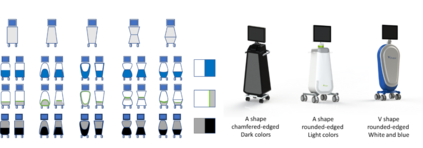Human-SAR (socially assistive robot) relationships vary by the context of use and interaction level. We argue that context and interaction considerations must be incorporated into the SAR's physical design requirements to align the robotic visual qualities (VQs) with users' expectations. We propose to consider situational-based and dynamics-based human-SAR relationship models in constructing the requirements. Previous studies contributed to the understanding of users` perceptions and preferences regarding existing commercially available SARs. Yet, very few studies regarding SARs' appearance used designated SAR designs, and even fewer evaluated isolated visual features. In this work, we aim to systematically assess the effect of isolated VQs. To achieve this, we first deconstruct the VQs attributed to SARs. Then, a reconstruction of body structure, outline, and color scheme was done, resulting in the creation of 30 new SAR models that differ in their VQs, allowing us to isolate one character at a time. We used these new designs to evaluate users' preferences and perceptions in two empirical studies. Our empirical findings link visual qualities with perceptions of SAR characteristics. Together with the relationship models, the outcomes are an exemplar of how to form guidelines for the industrial design processes of new SARs to match user expectations.
翻译:根据使用和互动水平的不同背景,我们主张,必须将背景和互动考虑纳入合成孔径雷达的物理设计要求,以便使机器人视觉特性(VQs)与用户的期望相一致。我们提议在建立要求时考虑基于情境和动态的人类-合成孔径雷达关系模型。以前的研究有助于理解用户对现有的商业可用的合成孔径雷达的看法和偏好。然而,关于合成孔径雷达外观的研究很少使用指定的合成孔径雷达设计,甚至更少的评估孤立视觉特征。在这项工作中,我们的目标是系统地评估孤立的VQs的效果。为了实现这一点,我们首先将归因于合成孔径雷达的VQs拆解。然后,我们进行了体形结构、轮廓和颜色计划重建,从而产生了30个新的合成孔径雷达模型,这些模型在现有的商用孔径雷达上有所不同,使我们能够一次孤立一个个性。我们用这些新的设计来评估用户的偏好和认知。我们的经验发现将视觉质量与合成孔径雷达特性的认知联系起来。与关系模型一起,我们首先将合成孔径雷达结构、轮廓与新设计过程的用户期望相匹配。































